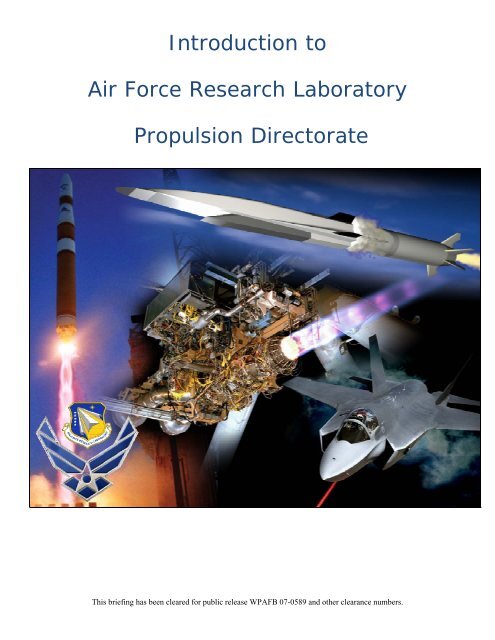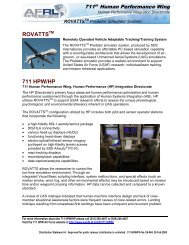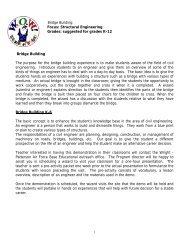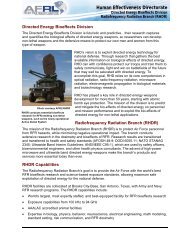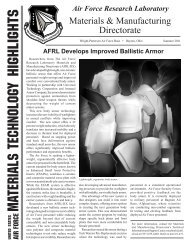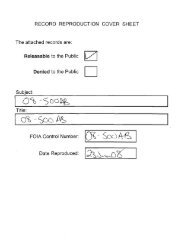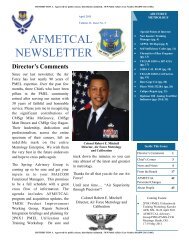Introduction to Air Force Research Laboratory Propulsion Directorate
Introduction to Air Force Research Laboratory Propulsion Directorate
Introduction to Air Force Research Laboratory Propulsion Directorate
You also want an ePaper? Increase the reach of your titles
YUMPU automatically turns print PDFs into web optimized ePapers that Google loves.
<strong>Introduction</strong> <strong>to</strong><strong>Air</strong> <strong>Force</strong> <strong>Research</strong> Labora<strong>to</strong>ry<strong>Propulsion</strong> Direc<strong>to</strong>rateThis briefing has been cleared for public release WPAFB 07-0589 and other clearance numbers.
<strong>Propulsion</strong> Direc<strong>to</strong>rateMission and VisionMISSION: To create and transition propulsion and powertechnology for military dominance of air and spaceVISION: Maintain world leadership in militarypropulsion and power technology
AFRL’s <strong>Propulsion</strong> Direc<strong>to</strong>rateINTROCrpt Invst StratINITIATIVESTHRUSTSAIR- IHPTET/VAATE- Fuels/L/C- PowerSPACE-Boost/US/OT- Spacecraft-Space PowerWEAPONS-IHPTET Exp.- Hypersonics- Strategic Msls.- DE PowerSUMMARYest. 1947Edwards AFB, CAProduct Line• Liquid Engines• Solid Rocket Mo<strong>to</strong>rs• Spacecraft <strong>Propulsion</strong>• Propellants, Combustion, NozzlePlumes, Materials Applications• 550 programs• Almost 1,000 people• ~$350M/yr (FY08 PB)• $3B in facilitiesest. 1917Wright-Patterson AFB, OHProduct Line• Gas Turbine Engines• Power/Thermal Subsystems• Hypersonic <strong>Propulsion</strong>• Fuels, Lubricants, MechanicalSystems, CombustionWith the formation of AFRL, the <strong>Propulsion</strong> Direc<strong>to</strong>rate was formed from our Wright-Pattersonsite and our Edwards site; both teeming with heritage in the development of propulsion andpower technologies for the war-fighter. Our "East" site has its roots in McCook Field just northof Day<strong>to</strong>n and was established in 1917. Our "West" site, which emerged from Wright-Pattersontechnical developments in rocket propulsion was established in 1947 for rocket hardware, andthen another "trek" occurred in 1959 when rocket propellant work also moved <strong>to</strong> Edwards. Thedirec<strong>to</strong>rate consists of almost 1,000 people running approximately 550 R&D programs frombasic research <strong>to</strong> advanced technology development. Our FY08 President's Budget is $350M,and our combined facilities at the two locations represents approximately $3B in plantreplacement costs. Product lines at the Edwards site include everything having <strong>to</strong> do withrocket and spacecraft propulsion from the boost engines for space launch <strong>to</strong> solid rocket mo<strong>to</strong>rsfor our ICBM fleet. Spacecraft propulsion includes both chemically and electrically-basedforms, and our efforts in advanced high energy density materials, propellants and nozzle plumesis world class. Here at the Wright site, we lead the Nation's turbine engine technology and areresponsible for all aircraft electrical power and thermal management technologies. We conducthydrocarbon-fueled hypersonic propulsion research and development, and our fuels researchincludes SECAF's goals in the development and qualification of synthetic aerospace fuels andblends with conventional fuel.
Rich His<strong>to</strong>ry of <strong>Propulsion</strong> & PowerPikes PeakLiberty Engine1 st US 1000hp engJ31 TurbojetV1710J58 turboramjetSR-71 engX-15SuperchargersFlying Tiger P-40sP59 w J31 engApolloF-1 engTF-39 for C-53000 hp WASP<strong>Air</strong> CooledRadialJ57 DualSpoolF100 AB TurbofanHubble w/Ni-HbatteriesSiloTestAtlasDuraluminumPropellerThrustVec<strong>to</strong>ringNozzleEarlyFuelCell5The <strong>Propulsion</strong> Direc<strong>to</strong>rate has been involved in the research and development ofmilitary aviation propulsion and power technologies since the beginnings ofmilitary flight at McCook Field near Day<strong>to</strong>n Ohio. The original organization, thePower Plant Section, was formed in May, 1917. Since that time, engineers andscientists of the <strong>Propulsion</strong> Direc<strong>to</strong>rate have been involved in establishing everincreasingpropulsion capabilities, the pacing item, for every new US Army <strong>Air</strong>Corp and the US <strong>Air</strong> <strong>Force</strong> aircraft. From the Liberty engine that powered the DH-4 <strong>to</strong> the thrust vec<strong>to</strong>ring nozzle development for the F-119 engine powering the nextgeneration air superiority fighter, the F-22 Rap<strong>to</strong>r….the <strong>Propulsion</strong> Direc<strong>to</strong>rateleads the nation in future propulsion.
<strong>Propulsion</strong> & Power are Important!50-70% of satelliteweight 25-40% ofsystem cost the lifelimitingfac<strong>to</strong>r40-70% of cruise missile weight; the criticalfac<strong>to</strong>r in survivability, lethality, & reach70-90% oflaunch weight40-60% ofsystem cost45-80% of directedenergy weaponweight and volume60-80% of tactical missile weight the critical fac<strong>to</strong>rin range & time-<strong>to</strong>-target<strong>Air</strong> <strong>Force</strong> fuel costs were $6Bin FY06 alone40-60% of aircraftTOGW 20-40%of system lifecycle cost6The <strong>Propulsion</strong> Direc<strong>to</strong>rate has long been the largest direc<strong>to</strong>rate within AFRLbecause our technologies have significant performance impact on USAF weaponsystems. Here are some quantified examples of that impact. Turbine enginepropulsion and the fuels that are employed represent 40-60% of an aircraft's TakeoffGross Weight and 20-40% of the system life cycle cost. <strong>Air</strong> <strong>Force</strong> fuel costs aresoaring right along with the rest of the Nation, and our efforts there are leading theDoD in<strong>to</strong> the future of advanced fuels. A large weight fraction and half the systemcost for space launch (excluding the payload) are associated with our propulsiontechnologies. Our scramjet development represents a 40-70% weight fraction of anadvanced hypersonic cruise missile weapon and is the main contribu<strong>to</strong>r <strong>to</strong>survivability, time-<strong>to</strong>-target, and range. The rest of these provide similar impact andreflect why the <strong>Propulsion</strong> Direc<strong>to</strong>rate's technologies have such enablingcontributions <strong>to</strong> new weapon systems.
AFRL’s PR-EastFacilitiesBattery <strong>Research</strong>Supersonic<strong>Research</strong>“G” <strong>Force</strong>s on Heat PipesVortex-FlameVisualizationCompressor <strong>Research</strong>Ramjet Combustion<strong>Research</strong>Scramjet Combus<strong>to</strong>r<strong>Research</strong>High TemperatureSuperconductivityTurbine <strong>Research</strong>High TemperatureCombus<strong>to</strong>rLubricant QualificationHigh Pressure Combustion <strong>Research</strong>Altitude Simulation Compressor7The <strong>Propulsion</strong> Direc<strong>to</strong>rate's world-class facilities here at the Wright site include avariety of state-of-the-art labora<strong>to</strong>ries <strong>to</strong> support our line technology developments.Collectively, they represent approximately $1B in plant replacement costs. OurNational Aerospace Fuels <strong>Research</strong> Complex (NAFRC) leads the way <strong>to</strong> achieveSecretary Wynne's goals in synthetic fuels. Our high pressure combustion facilitiesare world-unique in that the low pressure aspects and continuous operation allowsus <strong>to</strong> simulate long duration, high altitude flight. We have three world-classfacilities for developing hypersonic propulsion. Test cell 19 is used <strong>to</strong> developadvanced hypersonic instrumentation and diagnostic techniques as well as fuelinjec<strong>to</strong>rs while test cell 18 scales these advanced components up from the researchrig. Test cell 22 then represents full-scale scramjet combus<strong>to</strong>rs. Our battery labshave led <strong>Air</strong> <strong>Force</strong> research and helped bring about the currently used lithiumrechargeable batteries that are on Mars and the Moon.
AFRL’s PR-WestFacilitiesSolidRocket Mo<strong>to</strong>rsAdvanced LiquidEngine <strong>Research</strong>Solid/LiquidPropellant <strong>Research</strong>X-33 Sub-scale EngineNational Hover TestFacilitySpace Environmental<strong>Propulsion</strong>Arcjet EngineAdvanced LiquidEngine <strong>Research</strong>Solid Propellant <strong>Research</strong>Satellite Engine ComplexLarge Engine Component Test Stand8The <strong>Propulsion</strong> Direc<strong>to</strong>rate's Edwards site is also home <strong>to</strong> a host of world-class andunique facilities dedicated <strong>to</strong> space launch and spacecraft propulsion. Interestingly,we cover the range from facilities <strong>to</strong> test nano-new<strong>to</strong>ns of thrust for micro-satellites<strong>to</strong> 1 million pounds of thrust for <strong>to</strong>morrow's space access vehicles. The "Rock"covers 65 square miles of California desert and represents approximately $2B inplant replacement costs. Witnessing full engine tests at the Edwards site of AFRL istruly an exciting experience.
Major <strong>Propulsion</strong> Programs• Adaptive Versatile Engine Technology (ADVENT)– $350M effort (SECAF-directed)• Integrated Vehicle Energy Technology (INVENT)– $150M effort• X-51 Scramjet Engine Demonstra<strong>to</strong>r– $200M effort (including DARPA)• Highly Efficient Embedded Turbine Engine (HEETE)– $130M effort• Hydrocarbon Boost - First stage boost enginedevelopment and demonstration– $275M effortThere are several major development and demonstration efforts currently ongoing within the<strong>Propulsion</strong> Direc<strong>to</strong>rate. The largest entitled Adaptive Versatile Engine Technology (ADVENT)represents a truly game-changing concept whereby the efficiency of a high-bypass turbine isbeing coupled with the ability <strong>to</strong> provide the dash capability of a fighter-class engine. Thisconcept was specifically identified by CSAF Moseley and Secretary Wynne as the propulsionsystem of choice for the next generation long range strike capability.The <strong>Propulsion</strong> Direc<strong>to</strong>rate’s X-51 program is the culmination of many years of supersoniccombustion ramjet (called the “scramjet”) development and is planned for first flight in AUG09.This test vehicle will represent the first flight of a hydrocarbon fueled scramjet which will lead<strong>to</strong> the world’s first hypersonic cruise missile weapon.The Highly Efficient Embedded Turbine Engine (HEETE) is another turbine-based gamechanger with the performance goal of dramatically reducing the specific fuel consumption ofnext generation turbines for future mobility and ISR air platforms. If successful, the conceptshould significantly lower <strong>Air</strong> <strong>Force</strong> fuels cost as well as increase range or time-on-station.The Hydrocarbon Boost program represents the next generation in US first stage boostengines. It is an essential component in the <strong>Air</strong> <strong>Force</strong> “Operationally Responsive Space”initiative.
What's Hot• Alternate Fuels – Synthetic JP-8• Efficiency• Configurations• PDE – Pulse De<strong>to</strong>nation Engine• Combined Cycle – Turbine, Scramjet, Rocket• Adaptive Turbine Engine Cycle• Reusable Rockets• Materials• Power/Thermal• <strong>Air</strong>craft – F-22, F-35, Next Gen Strike• DEW – laser gunship, high-power microwaveSecretary Wynne has established aggressive strategic goals regarding the USAF’s use ofadvanced synthetic fuels and blends with conventional fuels. Recently, our efforts rapidly andat greatly reduced cost qualified the B-1, B-52, and the C-17 on a 50/50 blend of JP-8 and syntheticfuel produced by the Fischer-Tropsch process. In this and all aspects of operations, efficiency hasbecome a major driver in the propulsion arena. A variety of high payoff, new propulsionconfigurations have been identified <strong>to</strong> including the pulse de<strong>to</strong>nation engine which could be highlyfuel efficient and achieve high mach speeds, the ADVENT program discussed earlier and reusablerockets. In order <strong>to</strong> achieve future ops tempo goals for space access, combined cycle propulsionschemes such as the use of air-breathing systems in combination with rocket propulsion will beessential. The <strong>Propulsion</strong> Direc<strong>to</strong>rate maintains a high degree of technicalcoordination/collaboration with AFRL’s Materials Direc<strong>to</strong>rate. New materials capabilities aredirectly related <strong>to</strong> dramatic increases in propulsion system performance. Between the F-22 andF-35, a paradigm shift occurred in that aircraft electrical power is now used <strong>to</strong> provide themotive force for flight control versus the use of fluid-based hydraulics. Management of thethermal energy within these systems has become an issue, and the <strong>Propulsion</strong> Direc<strong>to</strong>rate hasaccepted the challenge <strong>to</strong> fix these problems. Eventually, these same electrical power andthermal management technologies will enable future airborne electrically-driven directedenergy weaponry including non-lethal high power microwave and lethal laser weapon systems.
RocketsAFRL’s <strong>Propulsion</strong> and Power Investment(FY08-13 from FY08 PB ~ $349M/year)Hypersonics29%13%11%47%PowerTurbine Engines11The <strong>Propulsion</strong> Direc<strong>to</strong>rate's "core technical competencies" directly align with ourorganizational structure and our investment distribution is reflected here. Turbineengines including each of the critical subsystems as well as fuels represents thelion's share of the of the direc<strong>to</strong>rate's portfolio. Our Edwards site R&D in launchboost, spacecraft propulsion and associated propellants is approximately a third ofthe budget. The remainder of our budget is distributed between our hypersonicsand power/thermal R&D.
<strong>Research</strong> Opportunities in<strong>Propulsion</strong> and PowerFor one-year appointments through the NRC:http://nrc58.nas.edu/pgasurvey/data/aobooksFor summer faculty appointments through the ASEE:http://www.asee.org/sffp/For summer faculty appointments through AFRL/RZ:http://www.wpafb.af.mil/afrl/rzFor a listing of research <strong>to</strong>pics and advisors specific <strong>to</strong> propulsion and power:http://www.asee.org/sffp/afrl_propulsion.cfmTopics and advisors are the same for all programs.12SAB Overview 2004There are a variety of venues for the conduct of propulsion and power researchincluding appointment through the National <strong>Research</strong> Council, summer facultypositions with American Society of Engineering Education, an augmentation <strong>to</strong>wardthe ASEE through the Direc<strong>to</strong>rate.
<strong>Propulsion</strong> Direc<strong>to</strong>rateActive Contracts in Ohio$6.44M$3.23M$1.70M$3.89M$11.67M$217.75M$31.76M$18.04M$7.75M$113.98M$384.45M R&D$31.76M Support*Current contracts as of 16 OctCurrent <strong>to</strong>tal contract valuesas of 24APR0813SAB Overview 2004The <strong>Propulsion</strong> Direc<strong>to</strong>rate conducts a tremendous amount of business within thestate of Ohio. Almost $400M is invested in Ohio industry and academia <strong>to</strong> conductpropulsion and power research and development. Approximately $32M is spent<strong>to</strong>ward support.


